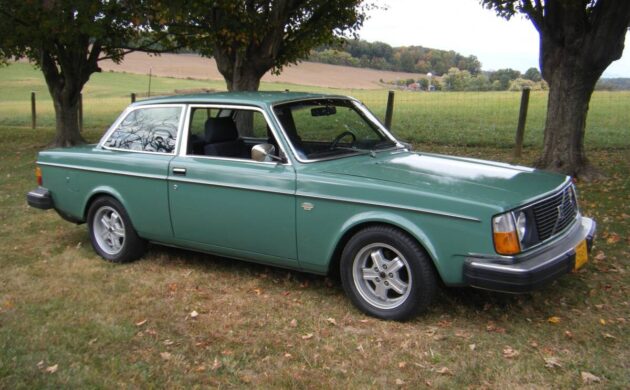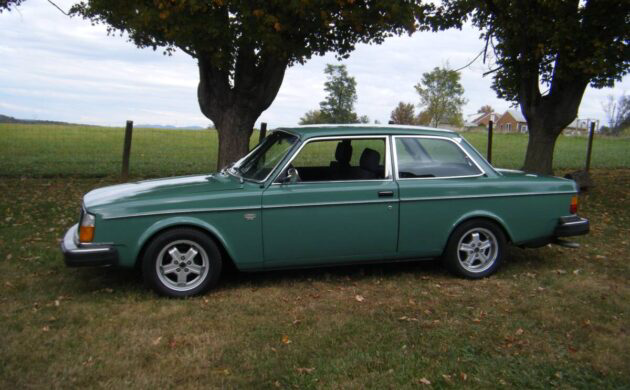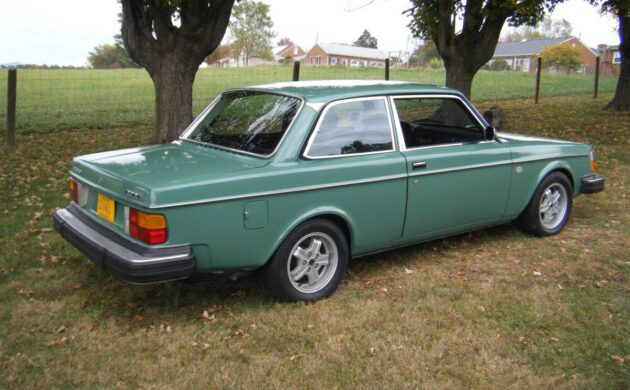Volvo spent decades carefully cultivating a reputation firmly founded on safety, but that doesn’t mean it didn’t produce interesting and impressive vehicles. The stunning P1800 makes the list due to its styling, while the 240T swept the opposition away in motorsport competition in Europe and Australia. Few would expect the humble 1979 242 DL to shine in such company, but our feature car has a few tricks up its sleeve. It is a tidy and rust-free classic with an owner who recently sank a considerable sum into mechanical upgrades. All good things must end, so they have listed it here on Craigslist in Waynesboro, Virginia. You could drive it home by handing the seller $15,500. I must say a big thank you to Barn Finder Pat L. for using a well-developed classic radar to spot this Volvo.
From the late 1960s until the end of the 1990s, it is fair to say that Volvo’s styling was conservative. It was only with the emergence of cars like the S40 that it became clear the company was looking beyond its staid roots to something more appealing to the buying public. However, it achieved something remarkable with its two-door 2-Series models. At first glance, they have all the aerodynamic efficiency of a barn, but the company managed to make them look quite elegant. I don’t feel the same way about the wagon, and I can only think that the different “glasshouse” design is what separates vehicles like our feature car from the four-door variants. This Volvo wears Lexington Green paint that presents nicely. It is unclear whether it received any previous restoration work, but flaws and defects are pretty minor. The panels are straight, and the gaps are consistent. Volvos of this vintage aren’t renowned for rust problems, and the supplied photos suggest potential buyers have nothing to fear. The trim and glass are impressive, but the freshly refurbished 15″ Volvo Virgo wheels add a perfect finishing touch to the exterior.
The drivetrain configuration of this Volvo leads us to another fascinating fact. Its engine bay houses the fuel-injected 2,127cc B21E four-cylinder engine producing 106hp. The power feeds to the rear wheels via a four-speed manual transmission, and while the journey down the ¼ mile might take 18.4 seconds, that figure only tells part of the story. The company spent a small fortune developing its joint-venture PRV V6 engine, which many potential buyers selected in preference to the four. However, its additional power of 123hp upon its release did not compensate for its heavier weight. Many owners were horrified to learn that placed head-to-head, the 242 could easily show the 264 a clean set of heels under most conditions. It was only when the question turned to that of top speed that the V6 edged ahead. This car’s engine and transmission are in excellent condition, with no problems or issues. It runs perfectly, and the transmission is smooth. There is another side to this car that helps it stand apart from the crowd. The seller sought performance improvements but didn’t want to touch the drivetrain. However, they added Bilstein B4 shocks on all corners, fitted B&G progressive-rate lowered springs, an enormous set of anti-sway bars, and wrapped the 15″ wheels in sticky Sumitomo rubber. The result is more grip than most mortals need, with the car tackling the twisting bits enthusiastically. There is a trade-off, which is the ride quality is harsh. The seller suggests it isn’t suited as a daily driver but should provide plenty of weekend enjoyment. For those drawn to this classic but who might be worried about the ride quality, the seller includes the original components so any or all of the changes can be reversed.
Our feature car’s interior follows typical Volvo practice, featuring boxy styling and plenty of dark plastic. However, its overall condition is pretty impressive. It looks like the door trim vinyl is wrinkled, but that problem is common. With patience, the new owner could stretch it into shape without spending a dime. The remaining trim is excellent, and there’s no evidence of crumbling plastic. The interior has a couple of aftermarket additions designed to improve comfort. The factory radio has vacated its regular spot, with a CD player taking up residence. More tellingly, the original front bucket seats are gone, replaced by a beautiful set of body-hugging Corbeau sports seats. While the seller installed those, he grasped the opportunity to add a new carpet set. The new seat upholstery may not match the original cloth on the back seat, but it still looks classy and comfortable. The interior and suspension upgrades came at a cost, with the seller holding invoices for more than $8,000 verifying the work.
I admit I quite like this 1979 Volvo 242 DL. I spent decades ignoring the marque, but the last car my father owned was a 242 GT. After years spent owning and tinkering with Blue-Oval products, I was shocked when he arrived home with his Volvo. However, my opinion changed when I slipped behind the wheel. These older Volvos are a surprise packet, and while our feature car offers no additional power, the suspension upgrades should help it stick like glue to the road. The 242 DL serves us another surprise because its recent performance in the classic market has been impressive. Regardless of condition, values have climbed by a staggering 20% in the past year. There is no evidence of the trend slowing, and although this one is priced above the market average, it could still represent a sound long-term investment that plasters a smile on your face whenever you hit the road. I can’t think of a downside to that equation.







This is a nice looking 240. The 2 doors are getting harder to find. Despite all the chassis improvements this ones ask is reaching. Especially with no od.
The four cylinder was also vastly more reliable than the PRV V6.
I had a 265GL 4 SP + OD in this color. The V6 was really thirsty as well. It did go ~250k miles despite being thrashed as my first car at 16. The gearbox got stuck in reverse. Wish I still had it.
I purchased a brand new one in 79. I drove it 180,000 miles and did regular maintenance on the car. This is one of the best automobiles I ever owned.
Interference motor?
No
Love this color (it is very rare) and of course the asking price is unrealistically high for what it is (even a ’79 wagon would be a stretch at this level).
Correction: That’s a B21F. The B21E had higher compression and wouldn’t meet US emissions, so it wasn’t sold here.
This is the most basic Volvo sold in the US for ’79. No P/S, no A/C, no O/D, no sunroof. Probably cost 1.5x what a stripped-out ’79 Chevy Nova would have cost. Lasted a lot longer, though.
Good to know
I was just going to comment on what you said. This is the base model and was probably cheaper than the 4-door base DL. That was pretty much what I had except in 4-door. I had the 4 round headlights on my 79 and A/C. I added power steering and the overdrive. No lowering springs but stock ride Boge shocks/struts but with IPD stabilizer bars and the Virgo wheels. Handled nice but you had to keep speed in the corners. She wasn’t exactly a rocket ship.
Very nice 240! yes, a survivor, yes in nice condition from what one can see, nice suspension bits but: no AC, no OD so in my estimation having sold these while in college, this car, while nice, is a quite strong ask at $10-12K. The suspension is maybe nicely fettled but if it is not daily driver quality then no thank you. The lack of the Laycock and AC is this car’s Achilles heel. I wouldn’t mind trading a car in my garage for this one.
For what it’s worth, my first car when I was in college was a beat up old Volvo 242, and while it was from the worst year Volvo had (1975), it was still a great car. I learned how to drive a manual gearbox on that car – when I bought it – I had no idea – by the time I got back from Colorado – I was easily able. It had a double-fulcrum clutch – which meant peddle pressure was low, engaging gears was easy, response was predictable – and even an idiot kid like me wasn’t likely to eat the clutch out of their parents Volkswagen Rabbit trying to figure out how to make it go…(don’t ask)!!
I learned how to work on the old 242 -and eventually started to fix other old Volvos for fun. I had a friend and he liked mine so much he bought a 142…and then we added a 145 to the crowd. I don’t know why – I just couldn’t let it sit and rot. I was a moron – but they were easy to work on, parts didn’t cost you most of your food and laundry money in college and you didn’t need specialty tools. I discovered the real benefit of them taking friends home with me from school – the downside is that they discovered their college dorm rooms pretty much fit into my wagon. Still not sure that was smart…but here we are.
For what it’s worth – none of the 240 motors were interference clearance engines. They were long-stroke, work-horse engines – that weren’t fast – but they could cruise up and down the interstate with passengers and luggage reasonably comfortably without working hard. If you forgot when you changed the timing belt – and it snapped – you’d coast to the side of the road – and if you were smart you had a spare with you and a metal fence post to use for leverage to pull the alternator tight while you retightened the bolt on the bracket. Thankfully, the hood could be raised to almost vertical for that fence post to fit. God the stupid things you do when you’re a poor and desperate college student!
I believe the basic engine came into being in about 1957 – and lasted through being modified into the 140 / 160 then remodified into the 240 series cars – they all used the same basic style block / head design – with variations to taste. Overall, they were absolutely bullet-proof (except 1975).
The 700 series cars introduced the 16valve engines in the GLE. In Italy, Volvo apparently made the 16Valve engine with a turbo. That marriage put the bullet-proof bottom end of a 240 engine, with the top using a twin cam head – and then added a turbo – because you couldn’t go fast enough with a twin cam 16 valve engine….powering a car with the weight of a small BUS!!!
While it was a good idea, the danger of this engine is that it is an interference clearance head that frequently put the valves into the pistons. In spite of rigourous maintenance and parts replacement ….hearing the sudden and dreaded sound of loud tapping at interstate speeds is a horrible feeling to recognize what’s going on – that you can’t stop – only to be made worse by a sharp CRACK!. One Volvo casualty later – It soured me on that head design.
Apparently, from what I’m told, its performance and design made it a head in demand to frequently convert 4 cylinder Mustangs to 16 valves apparently to give them better performance – Who knew!?!. Now, why anybody would do this is another question. It left me in favour of turbo-charging or straight 8 valve designs instead. I can fix a worn turbo much more easily than fixing damage to an engine.
The old 240 engine designs lived on into the 700 and 900 series cars in turbo, non-turbo variants. I have all three series currently – and love to drive them. The exception is the 960 – with a rumoured Porsche-consulting/designed, Volvo-built 6 cylinder.
While my life moved on – my car choices stayed with me. I’ve loved these cars for 30 years. They’re all pretty bulletproof and are easy to service. I still have Volvo’s from the 80’s/90’s that I drive regularly. My only advice is – if you have a Volvo – treat it gently. As hard wearing as they can be – the interior plastics and fabrics require more gentle care than a Japanese or American car. If carefully handled, they last forever. Also, These cars were undercoated from the factory – in a time before any other makers did this. I’ve learned this from years if maintaining them you can keep a nice Volvo nice with a bit of care. (wash it frequently – about once a week) – to keep dirt / junk off the car – and it won’t really rust – but it will also be a nicer experience to drive not turning your clothes grey trying to get into the car.
Though it used to be that when I told people I drove Volvos it was as though I’d told them I mounted a television on my roof! Blank stares and questions as to why I would choose to do this?! But oddly, now for some reason I get people randomly stopping at my house to ask if I’m selling my cars.
Not only are they predictable, reliable, boxy, and boring as hell to most people, They do what they say – and I can honestly say these cars have literally saved my life – and slightly surprised the accident investigators in the process.
So – for the road – buy a tank – or a Volvo – it’s the same!…but the Volvo is infinitely more comfortable than the tank!…and easier to park without an insurance claim!
got 20 yrs outta my 240 DL waggy and 18 from a 740 wagon. Used alota IPD go fast prts. “The flyin brick” w/a SBC or F, not mine, the standard (B23 motor? it’s beena few yrs). This is a nice car, not 15.5$ unless Waynesboro’s real near DC and for ur college kid… (safe, fun w/4 speed).
All those yrs & never knew they hada bent6 in any. Thnx, will look that up more~
My daughter was living in North Hollyood in 1996 … she asked me if I could come down and fix the brakes on her Volvo … since I had bought her a ’78 Plymouth Volare I had got on trade I was perplexed … she explained that it “came with the apartment” that she had rented … I was surprised the brakes had four pistons, some of which had frozen … after a few squirts of WD40 and a few whacks with a rubber mallet they were free … I don’t remember which year it was but it had well over 200k miles … when she moved a year or so later she left the car for the new renter … she said that was “just the way it works” …
Nice car, but why the aftermarket seats and rear speakers? Later model rims look ok. I would add the tach option to the instrument cluster, they are easy enough to find.
Oh yeah and the crackhead price????